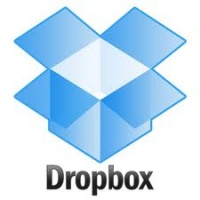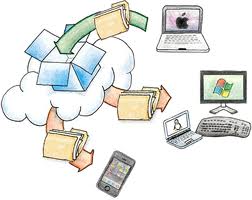Dropbox
|
Dropbox is a simple online virtual storage facility, making files accessible everywhere. The Dropbox interface mimics that of any opened folder on your computer and allows the same functions. It uses the Cloud computing model and allows synchronization over all other devices. The files are accessible from a user-made account through Dropbox.com.
Dropbox was founded by Drew Huston and Arash Ferdowsi, two MIT students who got "tired of emailing files to themselves to work from more than one computer."[2] Users can pay for more space, and Dropbox provides services for companies too. The folder can be accessed on multiple platforms across cellular and computing devices.
Contents
History
Dropbox was the output of Y Combinator's 2006 class. The company consisted of two employees in 2006, the founders themselves. As a start-up investment, it acquired $15,000 from Y Combinator and $1.2 million from Sequoia Capital. By 2008, the total start-up investment was raised, and investments came in from Sequoia Capital, Accel Partners, Y Combinator and individual investors to raise $7.2 million. By late September, Dropbox closed ivnestment deals with seven of Silicon Valley's elite venture capital firms[3].
How it works
Dropbox's model based on cloud storage allows sharing amongst people as well as within the user's account. Other users can be invited to share a particular file on the account and every member can add, edit and delete contents within the folder. Dropbox's system does not allow access to other folders on the account, and access to the folder requires an invitation from the host user through email. The enclosed folder can also by made public, and access to the folder can be provided with a given hyperlink.
To install dropbox, the user has to download the file from the official site. Downloads are available for most mobile devices as well. The folder is then installed on the hard drive, and files can be dragged or pasted into the Dropbox folder, and will automatically update on all devices. Access to the folder from multiple devices and sharing requires an account to be made on the website. To make an account, the user needs to simply provide basic information and set a password. The email provided links to the Dropbox account and sharing requests are delivered through the given email id.
Cloud Computing
Before Dropbox, users move files between computers using thumb drives. With the advancement of technology, four phenomenon arise: multiple gadgets, mobile workforce, faster networks, and dramatic drop on the price of digital storage. These trends were the main reason why cloud computing play such significant role nowadays. The cloud enables users to access photos, files, videos, or documents from any computer with internet connection. Dropbox offers their users with 2GB of storage for free given users a way to sync files between multiple devices and the cloud.
Social Media Integration
Dropbox has been slowly increasing it's place in social media networks, by installing incentive systems. For example, an additions 768MB is offered on your Dropbox account for every social media account linked to the Dropbox account. Users can also get access for an additional 8GB of space by recommending the service to peers, and 500MB of space is awarded for every new user the original user brings in. The recommendation system instilled on Dropbox makes it more widespread, and easier to share files for project work and collaboration. Dropbox has also entered email clients such as Sparrow, and users can drag files into a designated space on messages under composition, which are sent to the receiver through Dropbox.
Design
Dropbox uses a Freemium business model, which provides free core services, but charges premium for special or additional features[4]. The initial storage size provided is 2GB and upgrades up to 50GB are available. The model also allows for developers to implement a Value Sensitive Design (VSD) through the upgrades in technology for corporate clients.
Interface
Dropbox's interface merges in with that of the user's operating system, and looks like a generic folder. This is linked through the online network to an account on the site, to sync with the cloud storage facility and provide the folder on Mac, Windows, Linux, Android, iOS, and BlackBerry.
Google Drive vs. Dropbox
Google Drive is another web service that allows users to upload and share files. Drive allots users 5 gigabytes compared to the 2 gigabytes allotted to Dropbox users.
However, while both services allow for file storage, Drive also allows users to collaborate in real time, making it the better choice for those seeking a service for collaboration, whereas Dropbox is better suited to users looking to store and share files.
Additionally, Google Drive allows easier sharing with their invite feature - document owners simply need to enter the email addresses of those they would like to share the document with. Dropbox's, "share link", on the other hand, is a little less intuitive.
Users
The Dropbox demographics show 28% users in the United States, followed by 6% from Germany and 6% for the United Kingdom[5].
Ethical Issues
Privacy Concerns
With cloud storage increasing in popularity, privacy concerns are also increasing. Those concerned with the privacy of files uploaded to Dropbox should consider the following points:[6]
- Ensuring that the online data storage provider has an enforceable obligation to preserve confidentiality and security
- Investigating the online data storage provider’s security measures, policies, recoverability methods, and other procedures to determine if they are adequate
- Employing available technology to guard against reasonably foreseeable attempts to infiltrate the data that is stored
- Investigating the storage provider’s ability to purge and wipe any copies of the data, and to move the data to a different host
In June 2011, 68 accounts were hacked into and exposed due to a password breach. Dropbox demonstrates an open file sharing utility, and free users are offered only a core protection level for the information put on the folder. The easy accessibility of the application can also be contested as a privacy risk, as power over the account is held by a basic username and password key.
The shares accounts feature also fringes on potential privacy risks, as the invited user has the ability to tamper with any contents in the folder, and the access to the folder is through a simple email invite. For the kind of information that Dropbox is created for, especially regarding team information, this could prove dangerous. While the privacy is also infringed, the open model of sharing could inspire plagiarism or copyright issues.
Copyright Concerns
Dropbox's main goal is to facilitate sharing over a wider network using cloud computing. Music and movies included in this can cause copyright concerns, as piracy might grow through the sharing utility. Artists and labels do not receive compensation as Dropbox is not responsible for the content shared by its users, based on a contract the users must agree to while creating the online account.
Universities and corporate clients with an established Dropbox account receive upgrades and a more secure intra-network, but the information between the users shared over the official internet gives the authority access to all files. This could, in turn, create privacy issues amongst the individual users. Unless the network employed by the authority is closed, Dropbox could also be facilitating plagiarism as the sharing of information becomes more ubiquitous.
See Also
References
- ↑ Wikipedia Article
- ↑ https://www.dropbox.com/about
- ↑ http://activ8social.com/2012/04/08/brief-history-of-dropbox-infographic/
- ↑ http://www.freemiumbusinessmodel.com/
- ↑ http://webempires.org/w/dropbox.com
- ↑ http://www.digitalworkflowcle.com/11/2010/ethical-considerations-of-online-file-storage/

